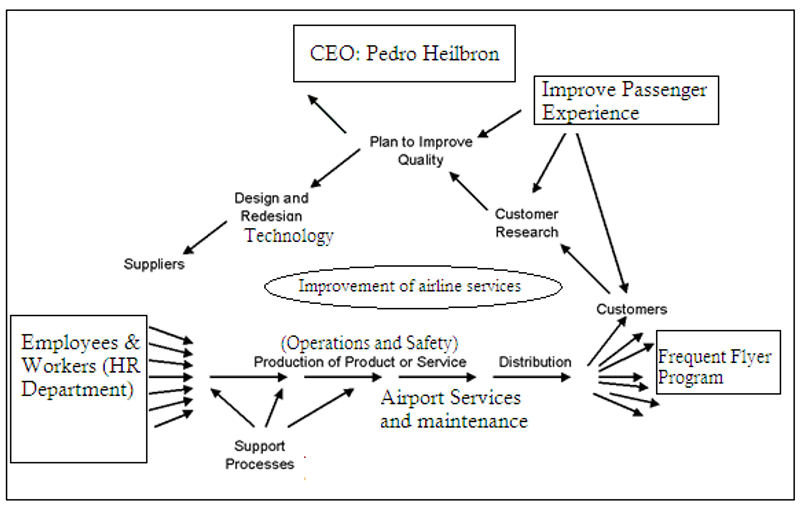Business Process
Corlett (2014) defines “the term business process as a set of tasks aimed at promoting a specific organizational goal” (p. 5). Business organizations tend to have a wide range of goals and objectives. The nature of the business process will therefore depend on the targeted goals. Several things should be included in every business process. To begin with, the business process should have a proper Process Flow Diagram (PFD). The purpose of the PFD is to outline various tasks and activities that should be completed throughout the process.
The next thing to incorporate in the business process is an outline of the major persons or departments responsible for various tasks. Such activities or tasks should be completed effectively in order to achieve the targeted business goals. Some of the departments or positions might include team leaders, store managers, assistant supervisors, and employees (Kim & Solomon, 2013). The inclusion of these positions will identify different tasks that should be completed in order to support the targeted goals. The business process should also describe the nature of the targeted results. Accurate and updated reports should also be included in order to promote the best actions.
According to Mele, Pels, and Polese (2015), a business process should omit every unnecessary activity. For instance, the nature of the business process will dictate the major aspects that should be included. Individuals without a role to play should be excluded. Unnecessary tasks should also be avoided whenever drafting a powerful business process. Such duties might not support the targeted goals.
Organizations as Systems
The “term organization as a system refers to a new perspective whereby various activities are interconnected in order to promote the best practices and goals” (Mele et al., 2015, p. 131). According to this perspective, everything within an organization is connected in order to work together. Corlett (2014) views a system as something composed of numerous parts that work together in order to complete specific tasks. Corlett (2014) also argues that “the concept of organizations as systems promotes new managerial practices that can address the needs of all components” (p. 12).
The above approach is superior to the traditional view of an organization. This traditional concept treats organizations as entities with different departments that operate separately. Some of “these departments include sales, production, customer service, marketing, and logistics” (Mele et al., 2015, p. 134). This kind of arrangement compels different workers report to their supervisors. The existing organizational departments also work separately. The concept also promotes labor specialization.
The Best Process View
It is agreeable that the process view of organizations as systems is appropriate for effective performance. This view encourages different employees to work together. Every unit will focus on the performance of the other departments. Decisions will be made faster thus promoting the best organizational outcomes. As well, the approach makes it easier for different organizations to embrace new business changes. Such organizations will manage their inputs, feedbacks, and processes effectively (Kim & Solomon, 2013). Various performance systems are also aligned in order to produce the best outcomes. The approach will also promote the best business processes thus delivering quality results.
Copa Airlines
The current organizational chart for Copa Airlines shows how different functional divisions report to the company’s Chief Executive Officer (CEO). There are also two sub-divisions that should report to the Senior Vice President of Operations. The targeted goal is to attract and fly more passengers. This approach will eventually produce more profits. A new system should therefore be designed whereby the Operations, Safety, Passenger Services, and Flight Operations departments will focus on the experiences of different customers (Kim & Solomon, 2013). The Flight Operations and Passenger Services departments should also liaise with the Frequent Flyer Program in order to attract more customers.

The Safety and Maintenance divisions should collaborate with the Flight Operations department in order to support the needs of more passengers. These departments should also collaborate with the HR department. This strategy will address the needs of different employees. The firm should also adopt new technologies in order to improve the experiences of different stakeholders. The CEO will therefore oversee the functionality of these complex processes. The proposed high-level business processes will eventually improve the performance of Copa Airlines (Corlett, 2014). The approach will attract more passengers and eventually make the firm profitable.
The Seven Domains Model
The Seven Domains Model focuses on specific aspects that determine the profitability of a specific business process. This model is closely related to the business process view. This strategy has nothing to do with the functional structure of a firm. The model identifies specific aspects that should be considered whenever implementing a business process. The organization will examine the macro and micro aspects of the targeted market. The next step is examining the skills and abilities of the internal team. The Seven Domains make it possible for managers to identify the most appropriate ventures for their organizations (Fisher, 2011). Business organizations can use the model to determine whether different processes will result in profitability or growth. This argument explains why business firms should use the Seven Domains Model whenever executing their businesses processes (Fisher, 2011).
Reference List
Corlett, J. (2014). Systems Theory Applied to Organizations. Web.
Fisher, J. (2011). The Four Domains Model: Connecting Spirituality, Health and Well-Being. Religions, 2(1), 17-28.
Kim, D., & Solomon, M. (2013). Information Security and Assurance Textbook: Fundamentals of Information Systems Security. Burlington, MA: Jones & Bartlett Learning.
Mele, C., Pels, J., & Polese, F. (2015). A Brief Review of Systems Theories and Their Managerial Applications. Service Science, 2(1), 126-135.